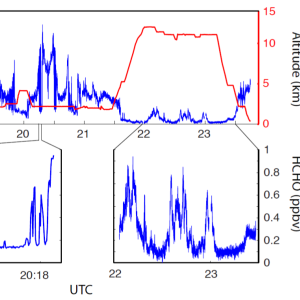The NASA GSFC In Situ Airborne Formaldehyde (ISAF) instrument measures formaldehyde (CH2O) on both pressurized and unpressurized (high-altitude) aircraft. Using laser induced fluorescence (LIF), ISAF possesses the high sensitivity, fast time response, and dynamic range needed to observe CH2O throughout the troposphere and lower stratosphere, where concentrations can range from 10 pptv to hundreds of ppbv.
Formaldehyde is produced via the oxidation of hydrocarbons, notably methane (a ubiquitous greenhouse gas) and isoprene (the primary hydrocarbon emitted by vegetation). Observations of CH2O can thus provide information on many atmospheric processes, including:
- Convective transport of air from the surface to the upper troposphere
- Emissions of reactive hydrocarbons from cities, forests, and fires
- Atmospheric oxidizing capacity, which relates to formation of ozone and destruction of methane
In situ observations of CH2O are also crucial for validating retrievals from satellite instruments, such as OMI, TROPOMI, and TEMPO.
Measurement Details
Integration Details
Additional Information
Accuracy: 10%



